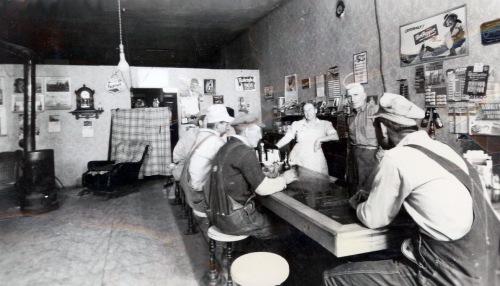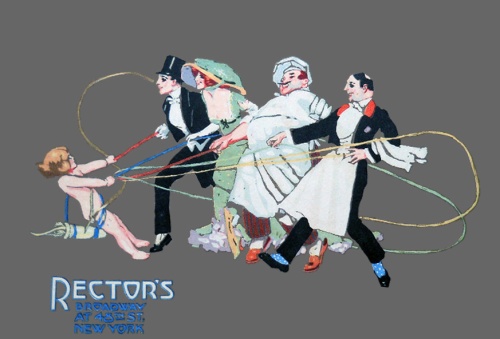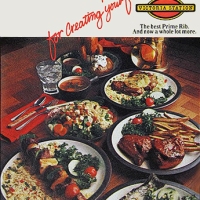In the vast majority of eating places customers never had to be told to “come as you are.” That’s how they were going to come – or else they weren’t coming at all. Farmers wearing overalls were likely to show up in small town cafes, while white collar workers in shirtsleeves grabbed seats in city lunchrooms.
Nevertheless, there was a segment of society that “dressed” for dinner. People of high society were accustomed to donning formal wear for dinner parties given in private homes. Then, as New York society began to expand beyond “the 400″ in the late 1890s, growing ranks of wealthy newcomers adopted formal dress for dinners in hotel dining rooms and swanky restaurants.
In the late 1890s men began to wear tuxedos for such outings. Women wore long gowns, cut lower than their daytime dresses. [Rector’s, 1913, illustrated] But the era of luxury dressiness was brief. After WWI, with prohibition forcing the closure of many fine restaurants and “lobster palaces,” more informal clothing became acceptable in most restaurants. What was known as afternoon wear – coats and neckties for men and daytime dresses and hats for women – became the new standard. But even that dress standard tended to erode.
It isn’t as easy to enforce a dress code as it might seem. As long as a restaurant isn’t using a dress code as a foil for illegal discrimination, it can set the dress bar as high as it wants. But will customers constantly challenge it? Even worse, will they shun the restaurant entirely?
Rejection of the Café de l’Opera’s formal wear requirement was cited as one reason for its sudden demise in NYC in 1910. And the 1930s Depression encouraged a lower standard. After World War II some predicted a return to elegance, but that proved shaky. Many well-established fine restaurants struggled with turtleneck-wearing male guests in the 1960s and 1970s. At New York’s “21″ the maitre d’ developed a practice of requiring necktie-less men to put on a hideously garish tie that he provided. This had the effect of either making them (a) leave, or (b) feel so embarrassed they never dared come without a tie again. Other places relented and admitted guests in “dressy casual” wear.
 A new restaurant wishing to enter the esoteric fine dining ranks, underwritten by a dining room of well-dressed guests, has to ask itself if it can pull it off. If it does not draw the “top-drawer” clientele it aims for it may find its dress code impossible to enforce. For instance, resorting to posting a “Dress Code for Ladies” notice near the front door, as a San Diego reviewer said of a restaurant there in 1981, is “simply tacky.” It is scarcely better than a sign reading “No shirt, no shoes, no service.”
A new restaurant wishing to enter the esoteric fine dining ranks, underwritten by a dining room of well-dressed guests, has to ask itself if it can pull it off. If it does not draw the “top-drawer” clientele it aims for it may find its dress code impossible to enforce. For instance, resorting to posting a “Dress Code for Ladies” notice near the front door, as a San Diego reviewer said of a restaurant there in 1981, is “simply tacky.” It is scarcely better than a sign reading “No shirt, no shoes, no service.”
Likewise, a restaurant may portray itself as elegant, on a postcard, publicity photo, or website, but rarely will the actual guests look quite so sophisticated as those pictured. And, needless to say, fancy dress does not in itself project elegance.
Today there is a small top tier of restaurants whose guests would not dare to wear shorts, t-shirts, baseball caps, or overlarge rubber-soled shoes. But, most restaurants are far more informal. Overall, “come as you are” – a phrase first used by churches — has remained in effect.
The phrase itself attained widespread use by restaurants in the 1960s when it appeared in advertisements for suburban establishments wishing to attract families. A new segment of chain restaurants came into being, a few notches less casual than fast food establishments, but entirely non-intimidating in their standardized cuisine, friendly service, and “fun” decor. Philip Langdon, in his book Orange Roofs and Golden Arches, sees the “chain dinnerhouses” as coming from the West (where restaurant dress rules were always more relaxed). Examples included Victoria Station, originating in San Francisco, and Steak & Ale, from Dallas.
At the present moment, at least, it is difficult to imagine a return to turn-of-the-century formality. I’d guess that even the 1% don’t like to dress up.
© Jan Whitaker, 2013















 It's great to hear from readers and I take time to answer queries. I can't always find what you are looking for, but I do appreciate getting thank yous no matter what the outcome.
It's great to hear from readers and I take time to answer queries. I can't always find what you are looking for, but I do appreciate getting thank yous no matter what the outcome.



Pingback: The Fancy Restaurant Compromise – Fashion, Media, Culture
Pingback: Dressed-up Dining - KaTom Blog
Ok, I’ve become slacker about dressing up even business casual at high priced restaurants.
My partner and I go on our own bike trips which means cycling with our clothing, etc. For me (and him), it means packing sensibly and light as possible because of cycling up to 80-100 km. daily or just we each want a carry-on luggage for airflight.
Yes, we have had $100.00 dinner at such restaurants in clean cycling clothing and walkable cycling shoes. We are served well. And do notice, the opposite just the few couple here and there who dress up in blazer, or lovely dress, high heels, etc.
As long as we’re clean, not smelly and polite with good table manners, what more could restaurants want from cyclists like us?
Believe me things are different on coastal town, ski/snowshoeing mountain resort areas…and cities with many cyclists around.
I like your blog subject focus, by the way.
I’m not actually recommending formality in dress but just gathering historical data about how the issue has been treated. But there are certain top restaurants, in the East and Midwest at least, where some degree of dressing up is required.
Not too long ago I (quietly) kicked up a fuss at the Cafe Carlyle when a patron arrived (and was seated next to our table) wearing a short sleeve shirt and jeans. All the other men in the room were wearing jackets, and most had ties on, too. When I asked the manager why this fellow was allowed in wearing such an inappropriate outfit when the stated dress code was for men to wear jackets, he brought the miscreant a sport jacket to put on, and required him to wear it. Under such circumstances (and at such places) I make no apologies for being what some may think of as persnickety, uptight, you-know-what. I consider it a matter of respect!
Respect for what?
This is a personal pet peeve of mine. I wouldn’t dream of going to La Grenouille/the Four Seasons/’21’ or similar without wearing at least a blazer at lunch, or a jacket/suit and tie at dinner, and it irritates me mightily when I see men (particularly men over 40) showing up at such places dressed otherwise. I was dismayed to see that ’21 relaxed its dress code on weekday nights last August, and the place was populated by slobs in shirt sleeves. Annoyed me no end. Such expensively and formally turned out places deserve the respect of proper/appropriate attire, as do the other guests who share the rooms (and who have the misfortune to look at the badly-dressed cretins who don’t have the manners to dress for such surroundings). I once complained at Locke Ober’s in Boston one evening that it had allowed patrons in wearing jeans and hoodies when the stated dress code was for men to wear jackets. The manager shrugged and said he couldn’t afford to turn them away. And now it has closed. I guess I’m a dinosaur.
Reggie — I wouldn’t say you were a dinosaur — but you are bound to be disappointed often. I’m somewhat ambivalent myself, but I admit I was displeased last night in a nice restaurant to see two men who looked as though they had come straight from the gym, both wearing shorts and one of them an undershirt style top. In my eyes the restaurant’s chic dropped 50% instantly.
Great job–again! I love your newsletter!
Ginger
Love the woman’s updo in the last photo!